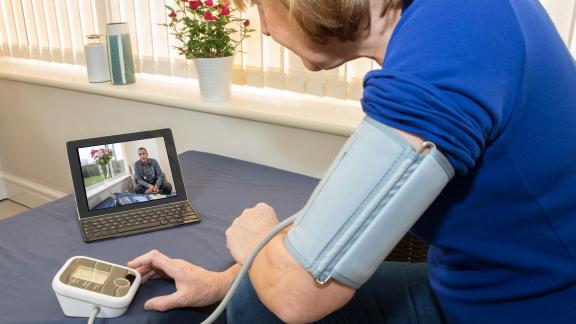How ICSs are moving care closer to home – four case studies

Nobody wants to be in hospital if they can avoid it and an unnecessary hospital stay can be detrimental to health – just getting to a hospital can be challenging for some people. Moving the NHS away from hospital as the default location for care is key to the ten-year plan. This process has been underway for a number of years and progress has been made in getting people home earlier or avoiding a hospital admission in the first place, often with different organisations working closely together.
Getting people out of hospital and back home, is essential to both aiding recovery and improving the flow of people through hospitals. When people get stuck in beds, the NHS struggles with both emergency demand and elective care.
Oxfordshire’s Transfer of Care Hubs
In Oxfordshire, staff from the Oxford University Hospitals Foundation Trust work with those from Oxfordshire County Council and community services, as well as colleagues from voluntary and housing services, in a Transfer of Care hub, to find a solution for individual patients as quickly as possible. It has helped to decrease the average length of time people wait to go home from hospitals – from 10 days in September 2022 to six in September 2024.
The number of acute hospitals beds occupied by patients who are medically ready to go home has also dropped by around 45 per day and the percentage of people returning directly home has crept up. The discharge to assess programme in the county is also seeing around 5000 people a year helped to return home safely with a plan in place for any support they may need.
Warwickshire’s innovative frailty service
Frail older patients who fall at home are often taken to hospital and may spend several days there before they are discharged, even if they have no serious injuries.
An innovative frailty service in Warwickshire aims to provide care close to home for some of this group – either avoiding a hospital admission at all or enabling them to return to their usual place of residence quickly. Half of patients are able to be cared for at home and just three per cent who go into hospital later need re-admittance.
Paramedics called out to an elderly person who has fallen are able to call frailty consultants and advanced care practitioners who will advise on whether they need to go to hospital. If they are admitted, they are seen early on by a frailty consultant and get a comprehensive geriatric assessment.
Once they are discharged, there is contact from a nurse and any packages of care are restarted as soon as possible. As part of the scheme, the local fire service also carry out “safe and well” checks, looking for fire risks and other safety hazards in the home.
Virtual wards across the South East region
Virtual wards across the South East have supported tens of thousands of people to leave hospital or avoid an admission entirely since they were set up in 2022. An evaluation of them in 2024 showed that, not only did they help people remain in familiar surroundings, there was also a positive financial impact for the NHS in the six ICS areas covered.
Across the six ICSs, there were nearly 2000 virtual beds with around half technologically enabled. A number of local providers, often working closely with other trusts in their areas, were involved in providing the care.
The analysis showed an estimated benefit to the NHS of over £10m a year, once the costs of running the wards was accounted for. The authors of the evaluation suggested this would increase as there would be economies of scale as more patients were admitted to virtual wards. However, black and minority ethnic patients were underrepresented in the groups admitted.
While the evaluation highlighted many learning points for those setting up virtual wards, patients were generally enthusiastic about being closer to family and in more comfort than could be provided in a hospital. Staff also appreciated developing new skills.
The benefits of community diagnostic centres
Many people struggle to get to hospital sites to undergo diagnostic tests – with public transport limited and often difficulties in parking. At the same time High Street shopping has declined, leaving vacant units in shopping centres.
Setting up community diagnostic centres (CDC) on these sites can make it easier for people to attend and offer economic benefits for town and city centres, as well as helping to “decompress” often crowded hospital sites.
The North Solihull CDC opened in 2025 and is expected to deliver 65,000 tests annually, opening 12 hours a day, seven days a week. It is one of the largest CDCs in the country and the first to open in a shopping centre in the Midlands. The centre has involved the Birmingham and Solihull ICB, University Hospitals Birmingham Foundation Trust and private provider InHealth.



